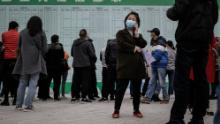China’s factories are producing more but the economy is still very fragile
Industrial output increased 3.9% in April from a year ago, according to data released Friday by the National Bureau of Statistics. That’s well above the 1.5% uptick that analysts polled by Refinitiv expected, and the first time output has grown since December.
The growth detailed on Friday can be attributed to the political pressure that Beijing is putting on factories to resume production, Julian Evans-Pritchard, senior China economist for Capital Economics, wrote in a research note on Friday.
He expects factory output to continue to grow, since policymakers in China have signaled that more stimulus measures are on the way.
But it wasn’t all good news on Friday for the world’s second largest economy.
Domestic demand remains very weak: Retail sales in China dropped 7.5% in April from a year earlier.
“We need to fully assess the risks and challenges” of the pandemic, said Liu Aihua, a spokeswoman for the NBS, at a press conference in Beijing on Friday. She said that as the virus ravages the rest of the world, China will continue to be affected, too.
The country’s recovery “continues but remains highly uneven,” Evans-Pritchard wrote, adding that the sectors of China’s economy that are driven by consumers are still struggling. The plunge in retail sales, for example, reflects a “continued strain on household finances,” he said.
Analysts expect measures aimed at keeping employment stable will be a key priority at that meeting.
“So far, there are many local subsidies for wages and factories to keep hiring stable. But it is obvious that this is not going to be enough,” said Iris Pang, economist for Greater China at ING.

